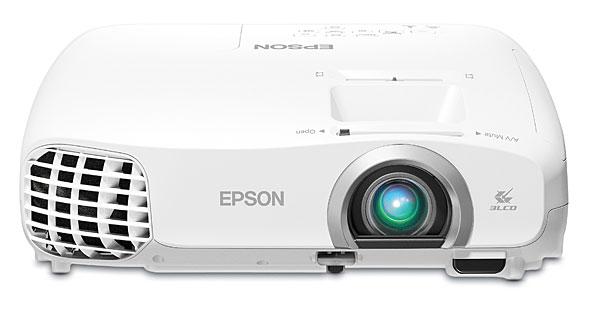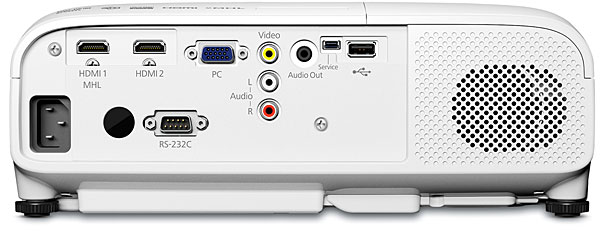Epson PowerLite Home Cinema 2030 3D LCD Projector

PRICE $999
AT A GLANCE
Plus
Bright 1080p for $1,000
No rainbows (for those
who care)
Minus
Contrast ratio is mediocre
Color accuracy is only average
THE VERDICT
Despite a bright image, poor contrast and otherwise average performance put Epson’s 1080p budget projector out of contention at the $1,000 price point.
I guess I shouldn’t have been surprised it was bright. I mean, it’s an Epson projector; of course it was going to be bright. But 42 foot-lamberts and 1080p for $1,000? That’s not too shabby. It’s perhaps even more impressive that all of that light bursts forth from such a tiny package.
Small, bright, a pair of HDMI inputs, even 3D capability: The PowerLite Home Cinema 2030 ticks all the boxes for a projector in our modern era. But box ticking is one thing, and not the thing we’re interested in.
The Bits
To hit the $1,000 price point with all those features, Epson had to leave out a few things. Most notably, any sort of lens shift. There’s a slight upwards fixed vertical throw when the projector is resting on its feet, which is typical, but should be considered in your planned mounting scheme. Yes, there’s a slider on top that allows you to add in some keystone correction, but all such processing is detrimental to the image, and you should use it only as a last resort.
Even the zoom range is pretty meager, which means you may need to move the projector closer to the screen for a smaller image, or further away for a larger one. The zoom lens gives you about 24 inches of wiggle room. So if you’ve already got a screen and plan to mount the 2030, make sure you’ve got ceiling space fore and aft of where you think you’ll want to place it.
To fill my Stewart StudioTek 100, 1.0-gain, 102-inch-diagonal 16:9 screen, I had to put the 2030 on the back of my sofa, peeking out over the cushions. This was approximately 10 feet away from the screen—just a few inches closer than most projectors of comparable price. It was also the most zoomed in I could get. I could have moved closer for the same size image and zoomed the lens out if my sofa wasn’t there. To be fair, however, the 2030’s limited range of placement options is generally on par with projectors in this category. The remote is small (good) and is not backlit (blah). It has lots of buttons (meh), and they’re all tiny (grrr).
Setup is simple, with lots of picture quality adjustments, as is typical for Epson. There’s even a full color-management system, a rarity in this price range.
Shine
Light output has been a performance characteristic that Epson seems to nail with every projector. It’s certainly the case with the 2030. While in the Cinema picture mode and the ECO lamp mode, it puts out 28.14 ft-L. That’s already more than some projectors at several times the price. Put it in Normal lamp mode, and you’ve got 44 ft-L.
That result isn’t just some fake brightness mode that sacrifices a rational color temperature to eke out every last lumen. Rather, those ft-L numbers are after calibration for the color temperature standard of D6500 with reasonably accurate color points.

This isn’t quite the insanity of the 2030’s little brother, the 750HD, which I reviewed on soundandvision.com. That little $800 wonder put out 75 ft-L. It was only 1280 x 800, however.
The 2030’s colors are a little off. Not enough to cause any visual oddities with actual video, but the image just wasn’t as lifelike as that of other displays I’ve seen with more accurate color. The color management system (CMS) lets you dial in the colors a bit, but not enough to get them fully accurate. You can dial in the gamut luminance (the “amount” of each color) really well, though, lining it up pretty much spot-on.
While 44 ft-L is great, the 2030 is quite loud in Normal lamp mode, exacerbated by the projector’s closeness to your head (at least in my setup). ECO mode is commendably quiet, however, making for one of the quieter small projectors I’ve reviewed. Since ECO offered a plenty-bright 28 ft-L on my screen, I used that mode for most of my subjective testing.
Brightness Isn’t Everything
Where the 2030 stumbles is in contrast ratio and, by extension, black level. Epson says the projector was optimized for brightness over contrast (to account for its use in high ambient light among non-enthusiasts), but still, the contrast was exceptionally low. The full-on/full-off native contrast ratio was only 316:1 in ECO lamp mode (331:1 in Normal), which is well below that of the projector’s DLP competitors, and way below the more expensive LCOS-based models from JVC and Sony. In comparison, last year’s 3020 (the $2,500 big brother to the 2030) had a native contrast ratio of around 7,000:1. The similarly priced BenQ W1070 DLP projector is around 1,953:1.
This is a big deal, as the image, compared with that of other projectors, seems washed out and flat. The black level is definitely a light gray. On a show like Castle, which features a lot of dark scenes and dark clothing (think black jackets), there’s a grayness that’s not great.
An auto iris tracks the incoming video to make dark scenes seem darker and keep bright scenes bright. This improves the dynamic contrast ratio some, to about 1,072:1. However, the auto iris in my sample was really noisy, with a grating plastic-on-plastic sound that’s rather annoying. Even the best auto iris can improve picture quality only marginally, and the difference here was outweighed, in my book, by the noise. I ended up turning it off halfway through my testing.
And not to keep flogging, but the brightness uniformity on dark images wasn’t great. Although I didn’t notice this with actual video, on test patterns the edges of the image were darker than the center, especially the left side. Note: The culprit wasn’t my screen, as this was the first time I’d encountered this issue.
Motion and Input Lag
All LCD displays, via projector or flat-panel TV, suffer from motion blur. With fast motion, the 2030 shows between 500 and 600 lines of resolution with a moving 1080p image. This is normal performance for an LCD. DLP usually fares much better with motion resolution (though it has its own issues in other tests).





























































